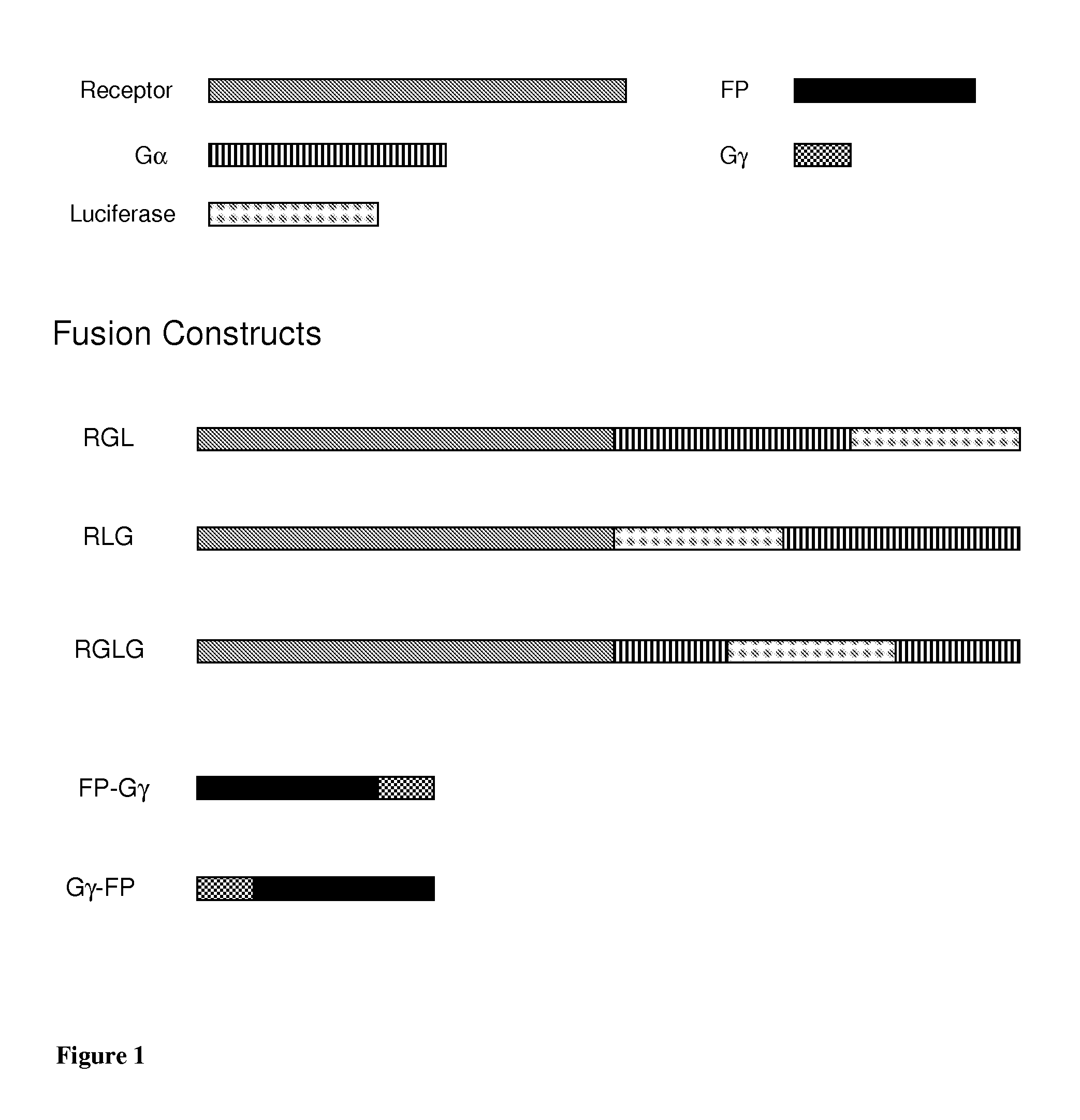Chimeric Polypeptides Useful in Proximal and Dynamic High-Throughput Screening Methods
a polypeptide and proximal technology, applied in the field of high-throughput screening methods, can solve the problems of false negative, difficult detection with such an end-point assay, and above-described binding assays cannot be used for the screening of allosteric modulators
- Summary
- Abstract
- Description
- Claims
- Application Information
AI Technical Summary
Benefits of technology
Problems solved by technology
Method used
Image
Examples
examples
Molecular Biology of Bret Systems
[0247]Several BRET systems comprising two separate partners (constructs) were prepared: RLG or RGL or RGLG and, various Gγ-FP, FP-Gγ constructs, in general Gγ9 was used (FIG. 1; Table 5). In these examples, the abbreviations RLG, RGL and FP may be used, in which “R” stands for receptor, “G” for G protein and “L” for luciferase. FP in Gγ9-FP or FP-Gγ9, for example, means fluorescent protein. Each construct contains a protein fused to either the luciferase or the fluorescent protein.
[0248]Table 5 and below summarizes the examples of the present specification and also indicates the figures that were obtained with assays using cells expressing the constructs of the invention. Examples 1-12 exemplify the preparations of constructs as detailed below. The Examples following Example 12 are all based on cells co-expressing the constructs as described in Table 5, in which further receptors and / or different construct types (RLG, RGL, RGLG1-3) were used. The con...
examples 1 and 2
Preparation of FPGγ9 and Gγ9FP constructs 1 and 2 (FP-Gγ9 and Gγ9-FP)
[0249]Human G-protein gamma9 nucleotide sequence was amplified from pcDNA3.1, Incyte Genomics (clone ID: GNG0900000). The yellow fluorescent protein YPet (A. Nguyen and P. Daugherty, in “Evolutionary optimization of fluorescent proteins for intracellular FRET”, Nature Biotechnology, vol. 23, no. 3, pp. 355-360) was also amplified from pcDNA (SEQ. ID. NO. 2).
[0250]The fusion protein Gγ9-YPet and YPet-Gγ9 nucleotide sequences were amplified by sequential PCR reactions, combining Gateway™ Cloning Technology (Invitrogen) and fusion PCR using the primers given below. The fusion primers contain regions that allow the Gγ9 DNA sequences to be fused with the fluorescent protein either on its C- or N-terminus. The Gateway™ Cloning primers contain regions that allow the integration of the fusion proteins into the Gateway™ Cloning vector pDONR™221 (Gateway™ Cloning Technology, Invitrogen).
[0251]FP primers for FP-Gγ9 fusion: Pr...
example 3
Preparation of the GPCR-Luciferase-Gαs Construct 1 (RLG)
[0260]The GPCR-Luciferase-Gαs construct prepared in this example contains three different domains: human GLP-1 receptor (hGLP-1R), a mutated Renilla luciferase (SEQ. ID. NO.:1), and the human G-protein subunit Gαs long (accession number NM—000516), all of which were fused in this order in the amino to the carboxy direction.
[0261]hGLP-1R DNA was PCR amplified from the human hypothalamus cDNA (Clontech, cat. nr. 639329) using primers 9 and 10 (SEQ. ID. NOs. 33 and 34). The obtained DNA was afterwards sequenced, put in the pTRE2-hygromycin vector and sequenced again.
[0262]Thereafter, the human GLP-1 receptor sequence without the stop codon was put into a Multisite Gateway pDONR™221P1-P4 vector (MultiSite Gateway® Pro Cloning Technology, Invitrogen), in accordance with the manufacturer's instructions using the following primers: Primer 11 and primer 12 (SEQ. ID. NOs. 35 and 36).
[0263]The mutated Renilla luciferase, the second eleme...
PUM
| Property | Measurement | Unit |
|---|---|---|
| frequency | aaaaa | aaaaa |
| concentration | aaaaa | aaaaa |
| wavelengths | aaaaa | aaaaa |
Abstract
Description
Claims
Application Information
 Login to View More
Login to View More - R&D
- Intellectual Property
- Life Sciences
- Materials
- Tech Scout
- Unparalleled Data Quality
- Higher Quality Content
- 60% Fewer Hallucinations
Browse by: Latest US Patents, China's latest patents, Technical Efficacy Thesaurus, Application Domain, Technology Topic, Popular Technical Reports.
© 2025 PatSnap. All rights reserved.Legal|Privacy policy|Modern Slavery Act Transparency Statement|Sitemap|About US| Contact US: help@patsnap.com



